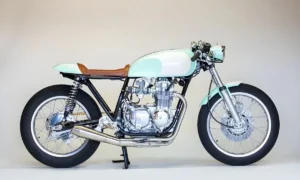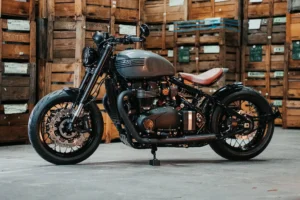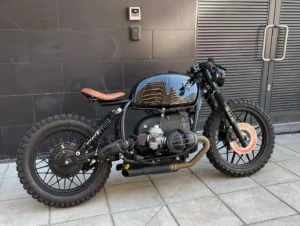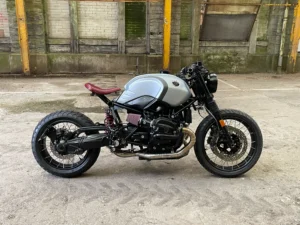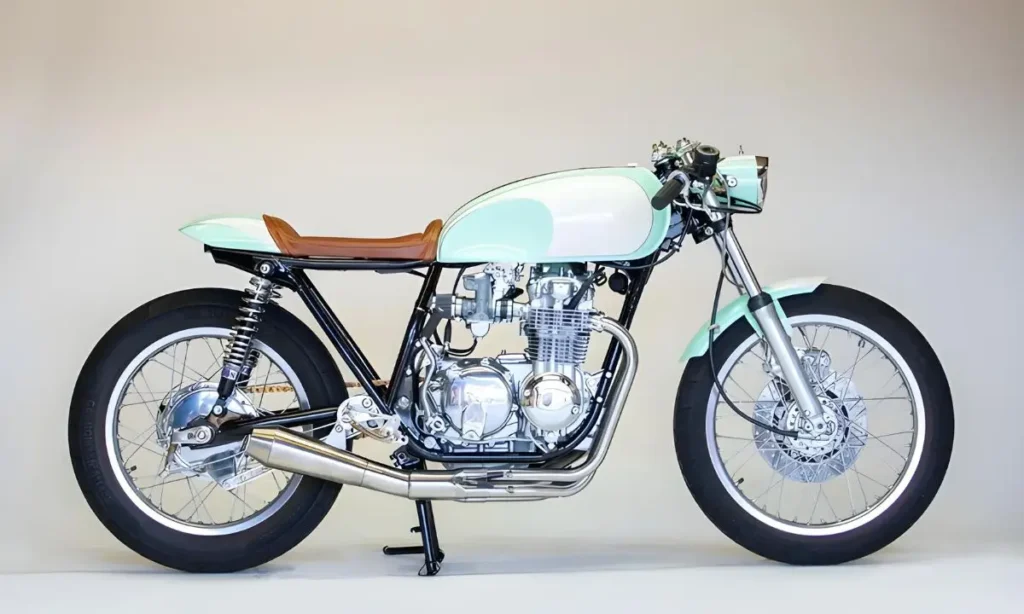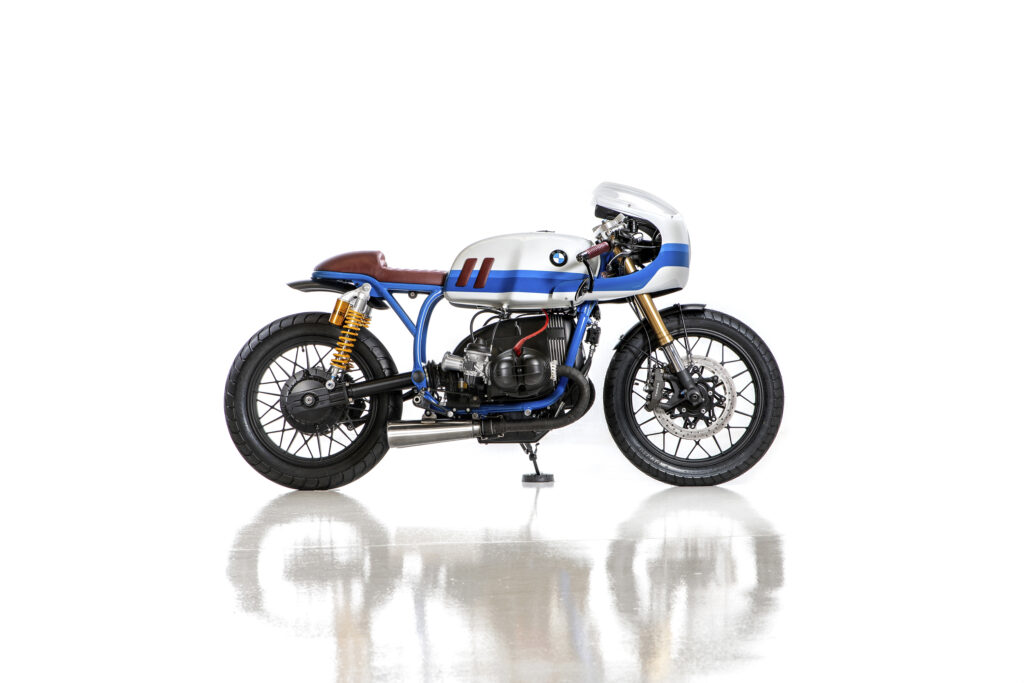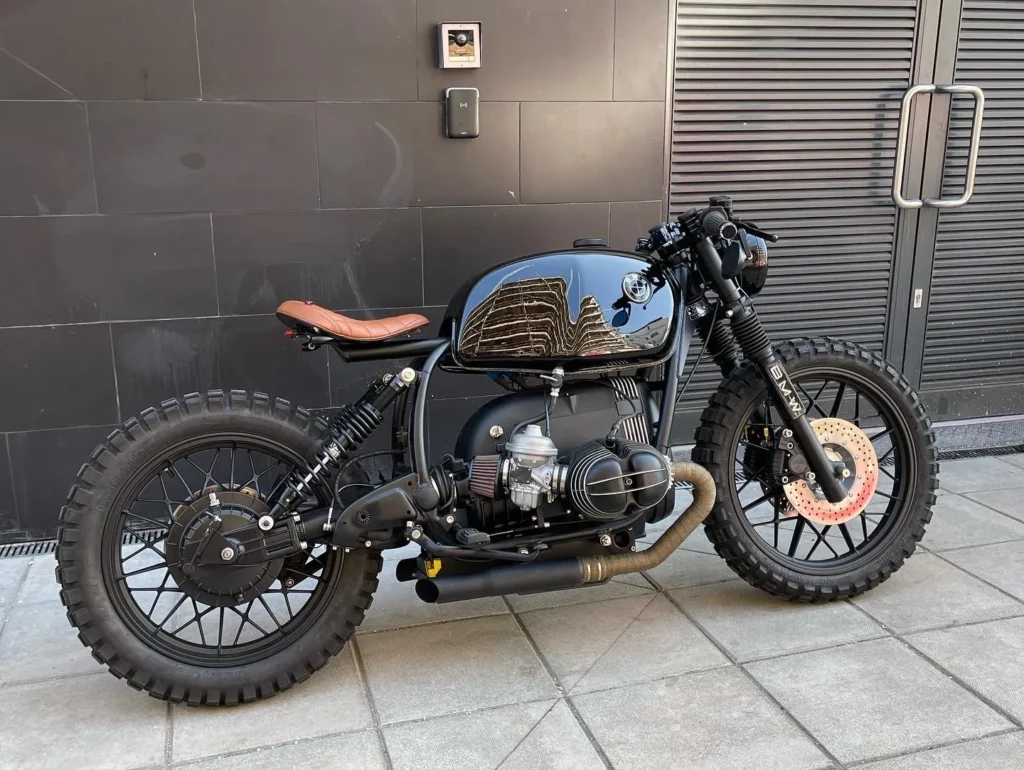Table of Contents
ToggleWhen building a café racer, one of the most important decisions is choosing the right engine cooling system. The two main types are air-cooled and liquid-cooled engines, each with its own advantages and challenges. Understanding the differences between these systems can help you make an informed decision for your project.
An air-cooled engine relies on airflow to regulate temperature, while a liquid-cooled engine uses coolant circulated through the engine to absorb heat. This article will explore the pros and cons of both systems, helping you choose the one that best suits your café racer build.
What Is an Air-Cooled Engine?
An air-cooled engine uses airflow to cool the engine’s internal components. As the engine runs, air is directed over the engine fins, which dissipate heat. This system is simple and lightweight. It doesn’t require any extra components like radiators or coolant. However, it depends on the bike’s speed and the amount of airflow for effective cooling. Air-cooled engines are often found in vintage motorcycles and café racers because of their classic look and ease of maintenance.
What Is a Liquid-Cooled Engine?
A liquid-cooled engine uses a closed system to circulate coolant through the engine. The coolant absorbs heat and carries it to a radiator, where it is cooled by air. This system keeps the engine at a more consistent temperature, even in high-performance conditions. Liquid-cooled engines are more complex than air-cooled ones and require more parts like a pump, radiator, and hoses. They are commonly used in modern motorcycles for better performance and reliability in various riding conditions.
Key Differences Between Air-Cooled and Liquid-Cooled Engines
Design and Construction
Air-cooled engines are simpler in design. They have fewer parts, relying mainly on fins attached to the engine. These fins help the engine release heat as air moves over them. Liquid-cooled engines, on the other hand, have a more complex design. They use a system of pipes, a radiator, and a pump to circulate coolant through the engine. This setup adds extra parts but provides more consistent cooling, especially in high-demand situations.
Cooling Efficiency
Air-cooled engines are effective at low speeds or in cool environments, as they rely on airflow to dissipate heat. However, they can struggle in heavy traffic or hot weather, where airflow is limited. Liquid-cooled engines provide better performance in all conditions. They can keep the engine at a steady temperature, regardless of speed or weather. This makes liquid cooling ideal for long rides or racing, where consistent cooling is crucial.
Maintenance and Repairs
Air-cooled engines require less maintenance. With fewer parts and no coolant to replace, they are easier to service. However, if something goes wrong with the engine fins or airflow, it may be harder to fix. Liquid-cooled engines demand more maintenance. The coolant needs to be changed periodically, and the radiator can clog or leak. These systems also require careful attention to the pump and hoses. However, their higher cooling efficiency often means less wear on the engine, leading to fewer issues over time.
Cost and Complexity
Air-cooled engines are generally more affordable. The simple design reduces manufacturing and repair costs. They also tend to be lighter, which is a benefit for café racer builds where weight is crucial. Liquid-cooled engines are more expensive due to their added components and complexity. While the upfront cost is higher, their reliability and performance in varied conditions can justify the investment.
Aesthetics and Space Considerations
Air-cooled engines are often favored for their classic look. The exposed fins give a vintage aesthetic, which suits café racers that want to maintain a retro feel. They also take up less space, giving builders more freedom for customization. Liquid-cooled engines, while efficient, are bulkier. The radiator and hoses can take up extra room, which may limit design options. However, their sleek, modern appearance may appeal to some builders aiming for a cleaner, high-performance look.
Pros and Cons for Café Racer Builds
Air-Cooled Engines
Pros
- Simple design with fewer components
- Lightweight, ideal for minimalist café racer builds
- No radiator or coolant system required
- Lower maintenance and repair costs
- Classic vintage look preferred by many builders
Cons
- Cooling depends on airflow, not ideal in slow traffic
- Prone to overheating in hot weather or heavy use
- Limited performance under long-distance or high-stress riding
- Less consistent engine temperature control
Liquid-Cooled Engines
Pros
- Provides stable temperature control in all riding conditions
- Handles long rides and hot environments better
- Reduces engine wear and improves long-term performance
- Suitable for high-performance or modern café racer builds
Cons
- More complex system with additional components (radiator, pump, coolant)
- Heavier, which may affect the build’s balance or design flexibility
- Higher initial cost and ongoing maintenance needs
- Requires periodic coolant replacement and system checks
Which Engine Type Suits Your Café Racer Project Best?
Riding Style and Environment
Your riding style and environment play a big role in choosing the right engine. If you plan to use your café racer for casual rides around town or short weekend trips, an air-cooled engine might be enough. It’s simpler and easier to maintain for less frequent riding. However, if you plan on longer rides, especially in warm or crowded conditions, a liquid-cooled engine could offer better reliability. The liquid cooling system ensures the engine runs at a steady temperature, which helps prevent overheating during extended rides or in hot weather.
Customization and Build Simplicity
Air-cooled engines are ideal for those looking for a simple build with a vintage look. The fewer parts involved in air-cooling allow for easier customization. If you want a classic, minimalist café racer, an air-cooled engine fits well with that design approach. Liquid-cooled engines, however, may limit customization options due to their bulkier size. The radiator and extra components can take up valuable space in your build. However, if performance is your main goal and you’re willing to work with a more complex design, a liquid-cooled engine can still offer plenty of potential.
Budget and Long-Term Maintenance
For builders on a budget, air-cooled engines are usually the more affordable option. They cost less upfront and have lower maintenance needs. You won’t need to replace coolant or worry about the radiator system, which keeps repair costs low. On the other hand, liquid-cooled engines require a higher initial investment and more frequent maintenance. The coolant needs changing, and the radiator system can sometimes need repairs. However, liquid-cooled engines tend to last longer and run more efficiently, especially if you plan to use the bike frequently or for high-performance purposes.
Final Thoughts: Making the Right Choice
Choosing between an air-cooled and a liquid-cooled engine depends on your priorities. If you want a simple, classic look and don’t mind limited cooling in tough conditions, an air-cooled engine is a great choice. It fits well for a minimalist build and is easy to maintain. However, if you’re looking for better performance, reliability, and temperature control, especially for longer rides or in warmer climates, a liquid-cooled engine would be more suitable. It offers consistent performance and can handle more demanding conditions.
Consider your riding habits, budget, and build preferences. Air-cooled engines are affordable and easy to work with, while liquid-cooled engines provide higher efficiency but come with extra maintenance needs. Either option can work well for a café racer, depending on what fits your vision.
FAQs
Can I convert an air-cooled engine to liquid-cooled in a café racer build?
No, converting an air-cooled engine to liquid-cooled is not practical. These engines are built with different internal structures and components. Air-cooled engines lack the passages needed for coolant flow. Adding a radiator or pump system is also not possible without a full redesign. If you want liquid cooling, it’s better to choose an engine already designed for it. Converting is too costly, time-consuming, and unreliable for a café racer project.
Do liquid-cooled engines need more space in a café racer frame?
Yes, liquid-cooled engines need more space. You have to fit a radiator, hoses, and a coolant reservoir. These parts take up room in the frame and may limit how much you can customize the bike’s look. In smaller frames or vintage café racers, space can become a serious issue. If minimalism and open-frame design are important to you, air-cooled engines offer more flexibility.
Are air-cooled engines louder than liquid-cooled engines?
Yes, air-cooled engines are usually louder. They have less sound insulation and no coolant system to absorb heat or noise. The cooling fins also produce more mechanical sound. Liquid-cooled engines are quieter because the coolant and radiator help manage both heat and sound. If noise is a concern, especially in city environments, liquid-cooled engines might be the better option.
Which engine type is better for beginners building their first café racer?
Air-cooled engines are better for beginners. They have fewer parts, which makes them easier to install, troubleshoot, and maintain. There is no need to worry about coolant levels or radiator leaks. The wiring and plumbing are also simpler. This helps first-time builders stay focused on the main parts of the project without getting overwhelmed. Liquid-cooled engines are more suitable for experienced builders who are confident with complex systems.
How does engine type affect the resale value of a café racer?
The engine type can influence resale value depending on the buyer. A well-built café racer with a reliable liquid-cooled engine might appeal to those looking for performance and long-term use. However, buyers interested in classic style and vintage charm may prefer air-cooled engines. In general, build quality, engine condition, and styling matter more than cooling type. Still, liquid-cooled engines may offer broader appeal for modern riders.


